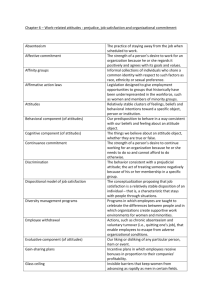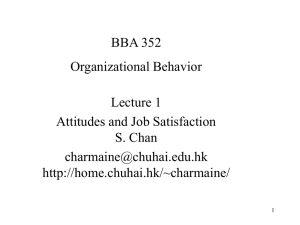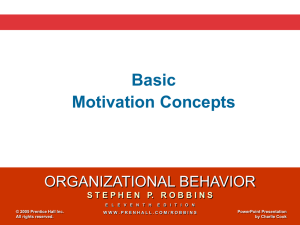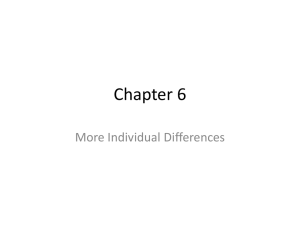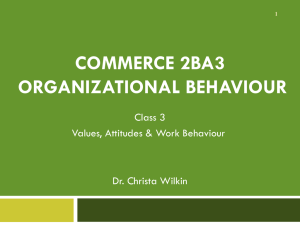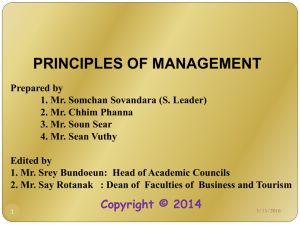Job Satisfaction
advertisement
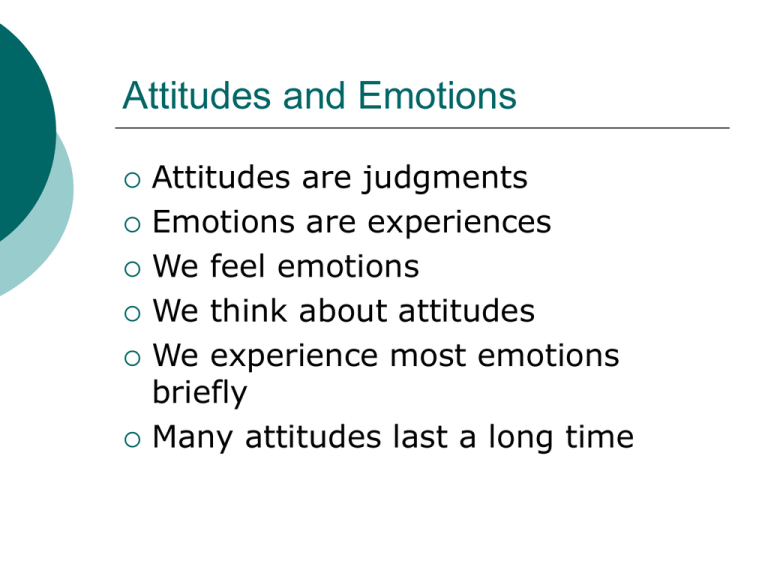
Attitudes and Emotions Attitudes are judgments Emotions are experiences We feel emotions We think about attitudes We experience most emotions briefly Many attitudes last a long time Model of Attitudes and Behavior Beliefs Attitude Feelings Behavioral Intentions Behavior Emotional Episodes Job Satisfaction – What is it? A person’s evaluation of his/her job and work context. A collection of attitudes about specific facets of the job. 85% of American’s report they have been satisfied with their jobs for the last 10 years. Measures of Job Satisfaction General or Global Job Satisfaction How satisfied are you with your current job? Facet Satisfaction: Satisfaction with Pay, Benefits, Supervision, Co-workers, The Job Itself, Promotional Opportunities, Job Satisfaction Employee job satisfaction is both a function of the person and the job environment. Person – characteristics like education, work experience, age, expectations, negative or positive disposition can affect job satisfaction Job Environment – management style or leadership, autonomy, work tasks, social support, the design of the job etc. Theories of Job Satisfaction Fulfillment theory – receiving more of something on the job is better Discrepancy theory – the perceived gap between what one wants from the job and what one perceives it is offering Equity theory – perceived equity in the employee’s outcome/input ratio compared to others Theories of Job Sat. Con’t Intrinsic/Extrinsic – intrinsic sources originate within the employee and have psychological value (i.e., challenging work, recognition, sense of accomplishment etc.) Extrinsic sources originate outside of the employee (i.e., working conditions, relationships with co-workers, supervisors etc.) Job Satisfaction and Behavior Job dissatisfaction increases turnover, absenteeism, theft Weak to moderate association with job performance Why isn’t this stronger? Satisfaction - Performance General attitudes (job sat.) don’t predict specific performance behaviors very well. Dissatisfied employees can still put out effort and work productively while complaining, looking for another job or waiting for something to be fixed. Satisfaction - Performance Job Performance leads to Job satisfaction but only when performance is linked to valued rewards. Higher performers receive more rewards, consequently they are more satisfied. Many organizations don’t reward good performance Satisfaction - Performance Job satisfaction might influence motivation but this isn’t real predictive of actual performance. The job sat. --->performance relationship is strongest when employees have control at work and more freedom. Organizational Commitment Affective commitment Emotional attachment to, identification with, and involvement in an organization Continuance commitment Belief that staying with the organization serves your personal interests – too costly to quit Commitment is Related to Turnover Absenteeism Customer Satisfaction Competitive Advantage Work Motivation Organizational Citizenship Possible Negative Consequences of Continuance Commitment Low-cost loans, stock options, deferred bonuses may tie employees to the company Continuance commitment is not necessarily loyalty Building Organizational Commitment Maintain fairness, values, and integrity Provide some job security Support organizational comprehension - communicate Involve employees in decisions Build trust

